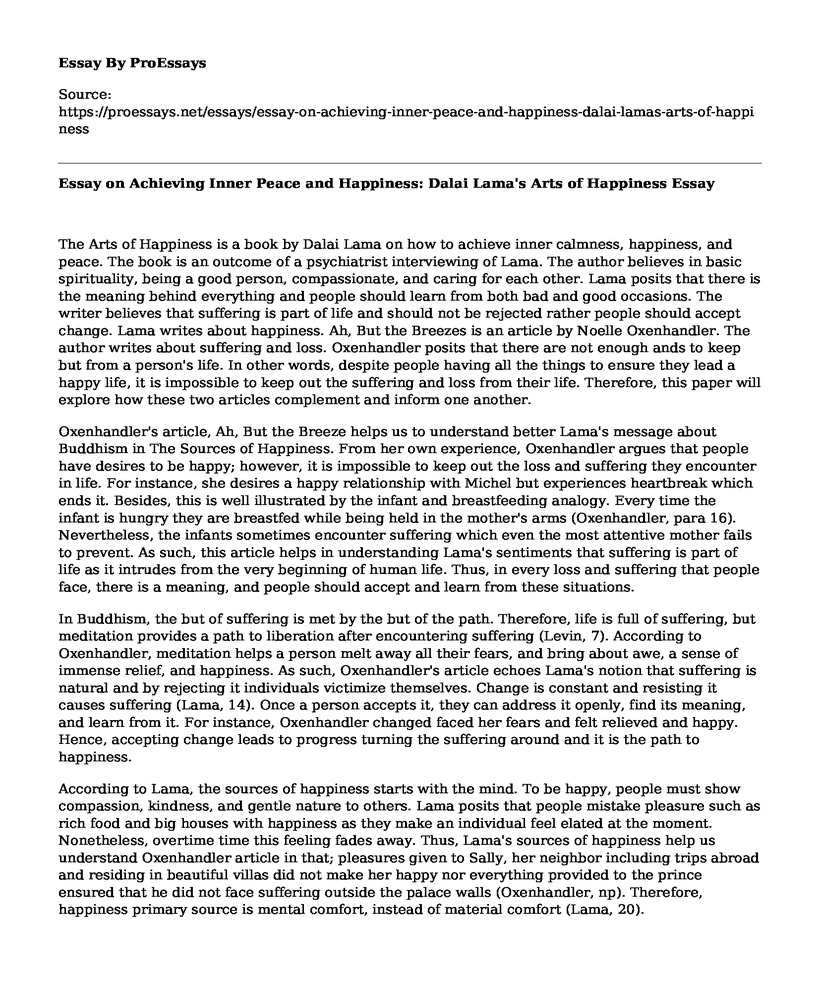The Arts of Happiness is a book by Dalai Lama on how to achieve inner calmness, happiness, and peace. The book is an outcome of a psychiatrist interviewing of Lama. The author believes in basic spirituality, being a good person, compassionate, and caring for each other. Lama posits that there is the meaning behind everything and people should learn from both bad and good occasions. The writer believes that suffering is part of life and should not be rejected rather people should accept change. Lama writes about happiness. Ah, But the Breezes is an article by Noelle Oxenhandler. The author writes about suffering and loss. Oxenhandler posits that there are not enough ands to keep but from a person's life. In other words, despite people having all the things to ensure they lead a happy life, it is impossible to keep out the suffering and loss from their life. Therefore, this paper will explore how these two articles complement and inform one another.
Oxenhandler's article, Ah, But the Breeze helps us to understand better Lama's message about Buddhism in The Sources of Happiness. From her own experience, Oxenhandler argues that people have desires to be happy; however, it is impossible to keep out the loss and suffering they encounter in life. For instance, she desires a happy relationship with Michel but experiences heartbreak which ends it. Besides, this is well illustrated by the infant and breastfeeding analogy. Every time the infant is hungry they are breastfed while being held in the mother's arms (Oxenhandler, para 16). Nevertheless, the infants sometimes encounter suffering which even the most attentive mother fails to prevent. As such, this article helps in understanding Lama's sentiments that suffering is part of life as it intrudes from the very beginning of human life. Thus, in every loss and suffering that people face, there is a meaning, and people should accept and learn from these situations.
In Buddhism, the but of suffering is met by the but of the path. Therefore, life is full of suffering, but meditation provides a path to liberation after encountering suffering (Levin, 7). According to Oxenhandler, meditation helps a person melt away all their fears, and bring about awe, a sense of immense relief, and happiness. As such, Oxenhandler's article echoes Lama's notion that suffering is natural and by rejecting it individuals victimize themselves. Change is constant and resisting it causes suffering (Lama, 14). Once a person accepts it, they can address it openly, find its meaning, and learn from it. For instance, Oxenhandler changed faced her fears and felt relieved and happy. Hence, accepting change leads to progress turning the suffering around and it is the path to happiness.
According to Lama, the sources of happiness starts with the mind. To be happy, people must show compassion, kindness, and gentle nature to others. Lama posits that people mistake pleasure such as rich food and big houses with happiness as they make an individual feel elated at the moment. Nonetheless, overtime time this feeling fades away. Thus, Lama's sources of happiness help us understand Oxenhandler article in that; pleasures given to Sally, her neighbor including trips abroad and residing in beautiful villas did not make her happy nor everything provided to the prince ensured that he did not face suffering outside the palace walls (Oxenhandler, np). Therefore, happiness primary source is mental comfort, instead of material comfort (Lama, 20).
Lama posits that happiness can be attained via efficient training of a person's heart and mind by reforming our outlook and attitudes (Lama, 15). A person can determine their happiness. Besides, life's essence is to seek happiness by persisting on those things that make people happy and removing those that make us suffer (Lama, 19). Thus, this enhances our comprehension of Oxenhandler's sense of relief after meditation. As such, through meditation Oxenhandler was able to face her life's loss and suffering and achieved awe and a sense of relief, which is a path to happiness as explained by Dalai Lama.
Conclusion
In conclusion, both articles complement one another. Oxenhandler writes of loss and suffering in a person's life, which Lama views as a natural occurrence. Further, Oxenhandler comes into the realization that through meditation she can face her fears and achieve happiness, which Lama refers to as a path to true happiness. Besides, Oxenhandler's articles help us comprehend Lama's notion that life is suffering; this is through her own experiences, Sally her neighbor, the prince, and infant analogies. Moreover, she helps understand the process of achieving mental comfort, which is a path to happiness as it starts from the mind as Lama posits.
Works cited
Lama, Dalai. The art of happiness: A handbook for living. Penguin, 2009.
Levine, Marvin. The positive psychology of Buddhism and Yoga: Paths to mature happiness. Routledge, 2011.
Oxenhandler, Noelle. "Ah, But the Breezes..." Tricycle: The Buddhist Review, 1 Dec. 2002, tricycle.org/magazine/ah-breezes/.
Cite this page
Essay on Achieving Inner Peace and Happiness: Dalai Lama's Arts of Happiness. (2023, Apr 09). Retrieved from https://proessays.net/essays/essay-on-achieving-inner-peace-and-happiness-dalai-lamas-arts-of-happiness
If you are the original author of this essay and no longer wish to have it published on the ProEssays website, please click below to request its removal:
- Essay on My Interest in Psychology Careers
- Christian Counselling Essay
- Anxiety and Social Media Essay Example
- The Midsummer Night's Dream - Essay Sample
- Ethics Defence Paper Example on Work and Leisure
- To Kill a Mockingbird by Harper Lee: Citical Essay Sample
- Mr. Davis' Psychosocial Evaluation Case Study: Assessing Social & Mental Well-Being







